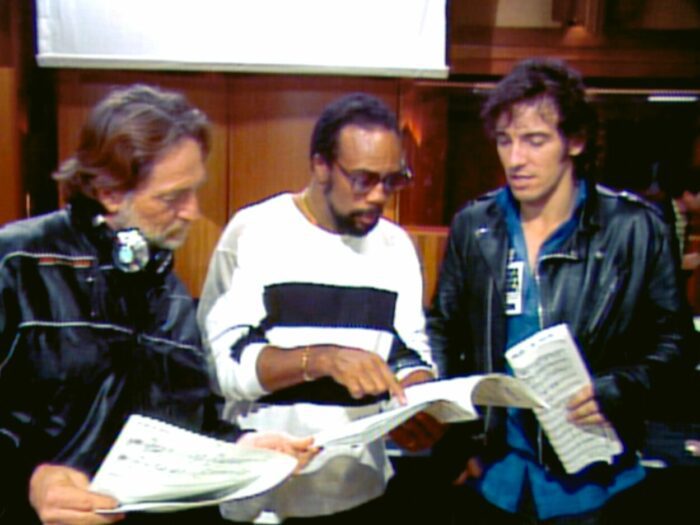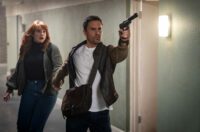Does the new Netflix documentary The Greatest Night in Pop, directed by Bao Nguyen and produced by Julia Nottingham, live up to its boastful billing? It’s hard to say no. Certainly, there had never been, before January 28, 1985, such an assemblage of musical talent in one place, one room even, at one time, or with such a singular purpose. And it’s hard to imagine that there ever can be again. Somehow, the music world’s greatest luminaries converged on a music studio to record a new song to benefit African famine relief, and the telling of the tale is every bit the equal of the worldwide hit they collaboratively produced.
Say what you will of the final result, whether you find it anthemic and uplifting or treacly and off-putting, “We Are the World,” the charity-single ballad written by Michael Jackson and Lionel Richie and performed by the select one-time only supergroup named “USA for Africa,” the song was a massive success, selling more than 20 million copies, the ninth-best-selling physical single of all time. If the melody is trite and the lyrics are little more than generic pablum, the collected talent took their mission seriously and delivered a surprisingly impassioned performance, one made all the more remarkable by the sheer complexity of the undertaking—one which The Greatest Night in Pop genially recounts.
Just consider the roster of talent lending their voices, every one of whom was among the world’s most celebrated musicians in the 1980s (and many of them for decades before, not to mention since): along with co-writers Richie and Jackson, Stevie Wonder, Paul Simon, Kenny Rogers, James Ingram, Tina Turner, Billy Joel, Diana Ross, Dionne Warwick, Willie Nelson, Al Jarreau, Bruce Springsteen, Kenny Loggins, Steve Perry, Daryl Hall, Huey Lewis, Cyndi Lauper, Kim Carnes, Bob Dylan, and Ray Charles all took turns singing lead. (The Jacksons, Pointer Sisters, Lindsey Buckingham, John Oates, Bette Midler, Smokey Robinson, and others chimed in on the chorus.)

That that roster could all be wrangled into the same room at the same time is astonishing in itself. That Richie, mostly, as the de facto master of ceremonies, his manager Ken Kragen, who led the project, and Quincy Jones (with Michael Omartian) as producer, could keep the collection of egos and spirits in check and the production on track is something of a minor miracle. Richie and Jackson arranged the song so that the twenty-plus leads could take turns, then harmonize, on a single short line of each verse, matching the melodies to each singer’s range and creating some fascinating collaborations (high-note heavy hitters Steve Perry and Daryl Hall) and unlikely juxtapositions (Dionne Warwick and Willie Nelson, or Paul Simon and Kenny Rogers).
The Greatest Night in Pop took place in a decade before we all had cell phones or even the internet and email to manage such a project. But nearly every moment of the evening—it ran late, until past 6 a.m.—was recorded on camera, and the combination of behind-the-scenes footage shot for its famous performance video alongside a number of recently-shot interviews reminiscing about the evening makes for a lively, enthralling narrative. There’s little suspense but lots of insights, reveries, and laughs. Among the current interviewees are Richie, Springsteen, Robinson, Lauper, Loggins, Warwick, and the always-genial Lewis, who in particular, as a late substitution for no-show Prince, had to step in on the final verse and deliver despite some of the most obvious knee-knocking stage fright you’ll ever see on camera.

His mounting anxiety, recollected as he watched his idols tear through their verses before getting to his own section, where he has to harmonize with an ear-splitting Lauper and powerhouse Carnes, is just one of the many anecdotes that keeps the presentation in The Greatest Night of Pop sprightly. There are mild jibes about Springsteen’s broken-glass grunting, Jackson’s infamous shyness, Jarreau hitting the bottle(s), Lauper’s baubles, Wonder singing Swahili, and Dylan nervously mumbling that play off each star’s idiosyncratic persona, all in good cheer. On a more serious note, there are the behaviors that threaten to scuttle (like in every collaborative project you’ve ever worked on) the mission: Sheila E. getting used, basically, to coerce Prince into showing, Prince then demanding to work alone, Wonder’s sudden “inspiration” to start a chorus in Swahili and Waylon Jennings’ xenophobic response to it.
Those, as we all know, got put to rest. Sheila E. and Jennings cut out, Wonder backed down, Jarreau got it together just long enough to deliver his line, and “We Are the World” became the massive worldwide hit it did. And nearly now 40 years after the fact, it’s hard not to think about those musicians from that night we’ve lost too soon. That some of them, let’s start with Willie Nelson, are still with us, fit, healthy, performing, at his case at age 91—is something to celebrate. We’ve lost Michael Jackson and Prince, Ray Charles of course, and so many important artists of that era (not to mention Kragen, without whom the project would not have existed), but remarkably, every other one of the key performers from that storied night is still with us.

The kind of collective commonality of good will on display in The Greatest Night in Pop is now a thing of the distant past. Need an example? Remember the vitriolic response to early Covid-era celebrities phone-crooning John Lennon’s “Imagine” a few years back? “We Are the World” and USA for Africa are very much a reminiscence of a now-distant past, but it’s an awfully enjoyable one for any fan of pop music or of any of the stars involved. What happened then, in January 1985, isn’t likely to happen again, for a dozen or more reasons, and what did is ably recounted in The Greatest Night in Pop.



